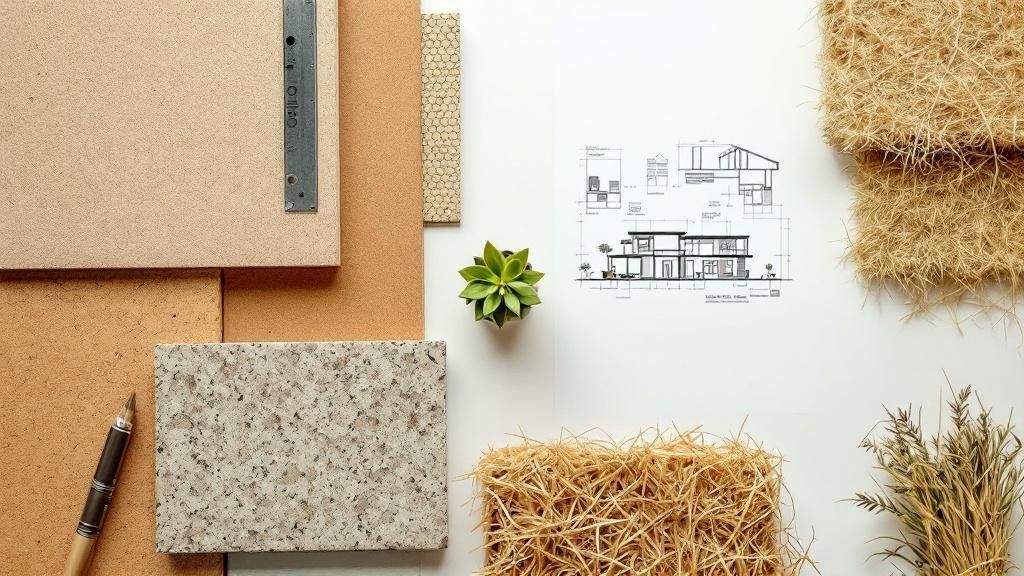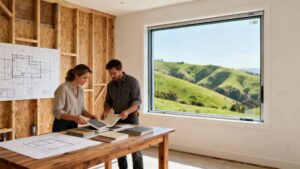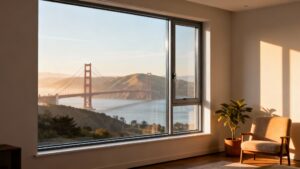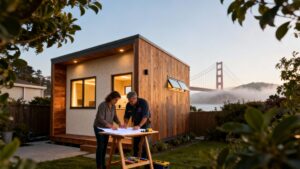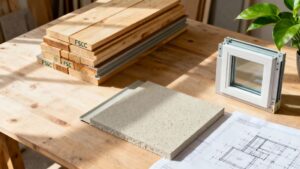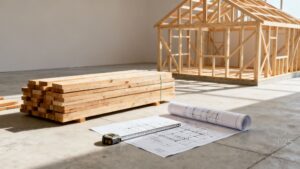When we talk about "eco-friendly construction materials," we're really talking about a smarter way to build for the future. These aren't just niche products; they are materials chosen to lighten a building's environmental footprint over its entire life. They're rooted in renewable resources, energy efficiency, and low toxicity, making them the foundation of responsible building, especially in a forward-thinking place like the Bay Area.
Why Sustainable Building Is the Future in the Bay Area
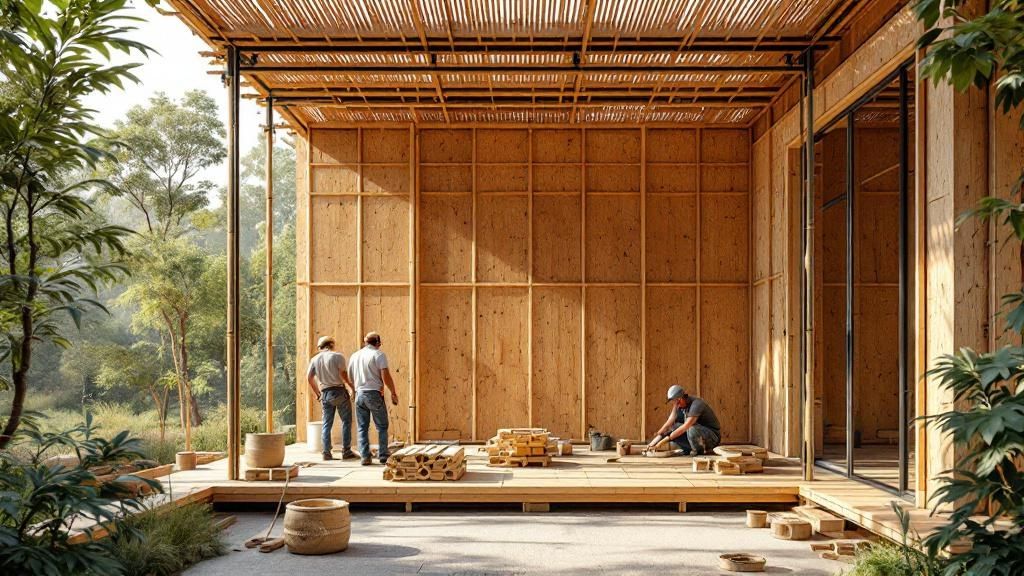
In the San Francisco Bay Area, the move toward sustainable building isn’t just a passing trend—it's a core strategy. For builders, contractors, and architects in Berkeley, Oakland, and beyond, choosing eco-friendly materials has become non-negotiable for creating resilient, high-value properties that stand out. This shift is fueled by California's progressive building codes, smart economics, and clients who are demanding healthier homes and workspaces.
Ultimately, it’s about building smarter, not just greener. Using sustainable materials helps projects sail through California's strict building codes, especially the Title 24 energy standards. It’s a proactive approach that builds real, long-term value into every Berkeley home or Oakland commercial project.
The Business Case for Building Green
The perks of using eco-friendly materials go way beyond just being good to the planet—they make solid business sense. These advantages hit on the top priorities for building professionals and property owners across the Bay Area.
A few of the key benefits include:
- Lower Operational Costs: High-performance insulation, energy-efficient windows, and advanced sealing drastically cut down on heating and cooling bills, a huge win for any property owner. According to the U.S. Department of Energy, heating and cooling account for nearly half of the energy use in a typical U.S. home.
- Increased Property Value: Homes built with sustainable features are in high demand in the competitive Bay Area market. They often command higher prices because of their lower running costs, superior comfort, and durable construction.
- Enhanced Occupant Health: Using materials with low or zero volatile organic compounds (VOCs) makes a tangible difference in indoor air quality. It’s about creating healthier, more breathable spaces for families and workers.
This approach delivers a superior final product. To see how all the pieces fit together, you can explore key energy-efficient home design strategies. For a deeper dive into how we put these ideas into practice, learn more about our commitment to green building.
Key Benefits of Sustainable Building Materials at a Glance
| Benefit Category | Description | Example for Bay Area Projects |
|---|---|---|
| Economic Value | Lowers long-term utility and maintenance costs while increasing the property's market value and appeal. | Using high-efficiency windows from brands like Marvin reduces reliance on A/C during Bay Area heatwaves, saving money and boosting resale value. |
| Environmental Impact | Reduces carbon footprint by using renewable, recycled, or responsibly sourced materials that minimize waste. | Choosing reclaimed wood for a deck in an Oakland Hills home diverts materials from landfills and adds unique, historical character. |
| Health & Comfort | Creates healthier indoor spaces by avoiding harmful chemicals (like VOCs), leading to better air quality and well-being. | Opting for low-VOC paints and natural fiber insulation ensures a safe, non-toxic environment for a family in their new Berkeley home. |
As you can see, the decision to build green is driven by tangible outcomes that benefit everyone involved, from the builder to the end user.
The global green building materials market is projected to skyrocket from approximately USD 316.1 billion in 2025 to USD 922.1 billion by 2035. This isn't a small shift; it's a massive industry transformation, pulled forward by regulations and customer demand.
At the end of the day, sustainable construction isn't just an alternative—it's the new benchmark for quality. It lines up financial goals with environmental responsibility, ensuring the buildings we create today are built to last.
What Qualifies a Material as Eco-Friendly?
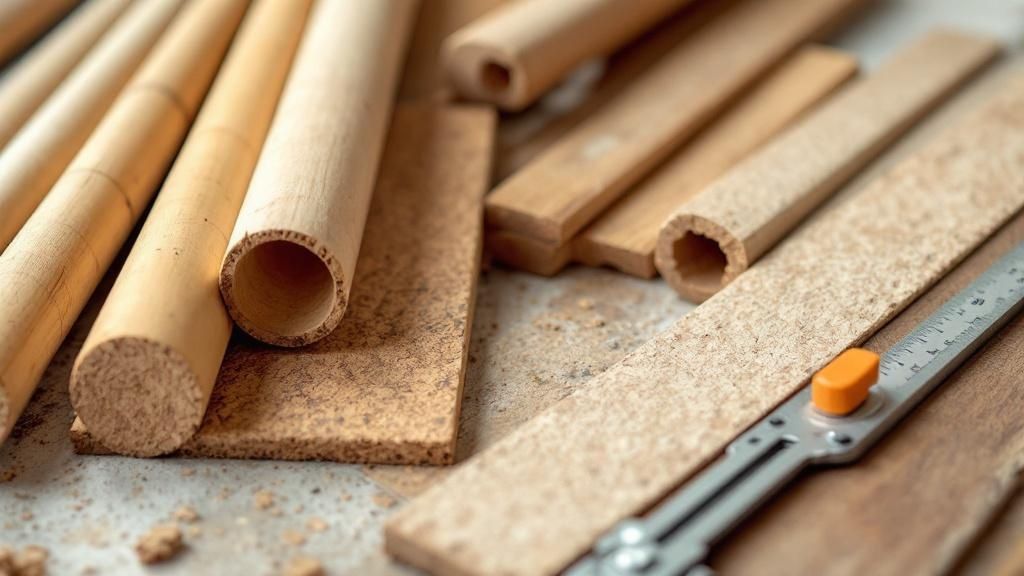
With so many companies jumping on the "green" bandwagon, it’s getting harder to tell what's genuinely sustainable and what’s just clever marketing. The key is to look beyond the label and understand a material's entire journey—from where it was sourced to what happens to it at the end of its life.
For contractors, architects, and homeowners in the Bay Area, this "lifecycle" thinking is what separates true performance from empty promises. It’s all about asking the right questions to ensure you're specifying a product that meets California's high standards.
The Lifecycle of a Building Material
A material’s real environmental footprint is the sum of its impacts from cradle to grave. We can break this journey down into a few key stages:
- Sourcing and Extraction: How did it start its life? For wood, that means coming from a responsibly managed forest, not clear-cutting. For recycled materials, it’s about being diverted from a landfill.
- Manufacturing and Processing: What energy and water resources did it take to create the finished product? Some manufacturing processes have a much lighter touch than others.
- Performance and Durability: How long will it last in the Bay Area climate? A product that stands the test of time and doesn't need constant replacement is a huge win for sustainability.
- End-of-Life Options: What happens when the building is eventually renovated or deconstructed? The best materials can be recycled, reused, or composted, ready for a second life.
According to Architecture 2030, buildings are responsible for nearly 40% of global energy-related carbon emissions. This makes sustainable materials a critical tool for any Bay Area builder looking to reduce their carbon footprint.
Demystifying Green Certifications
So, how do you verify claims without spending weeks researching? Third-party certifications are your best friend. They act as a trusted, neutral referee, giving a stamp of approval that confirms a material meets strict environmental and health standards. For professionals sourcing Berkeley building materials, knowing these labels is key.
Here are a few of the most respected certifications to look for:
- Forest Stewardship Council (FSC): This is the gold standard for wood. An FSC logo guarantees the lumber was harvested in a way that protects forests, wildlife, and local communities.
- LEED (Leadership in Energy and Environmental Design): While it's a rating system for the entire building, LEED heavily influences material choices. Using LEED-compliant products helps a project earn points toward this prestigious certification.
- Cradle to Cradle Certified®: This certification assesses a product's safety for people and the planet, ensuring it's designed for a "circular economy"—meaning it can be reused or returned to nature without causing harm.
- GREENGUARD: Focused on the air you breathe indoors, this certification flags products with low chemical emissions (VOCs), helping you create healthier spaces.
Understanding these labels is a must when you're looking for building supplies in Oakland. They cut through the marketing noise and give you the data-backed proof you need to build better.
Exploring the Best Eco-Friendly Building Materials
Now that we have a solid framework for what makes a building material truly sustainable, let’s explore specific options. The key is matching the right material to the right application, whether it’s for a new build in foggy San Francisco or a classic Berkeley bungalow renovation.
The demand for these products is booming. The sustainable construction materials market was valued at USD 301.6 billion in 2024 and is projected to hit USD 907.1 billion by 2034. You can dig deeper into the numbers in the full sustainable construction materials market report.
Comparing Top Eco-Friendly Building Materials
This table offers a quick look at some of the leading sustainable materials, comparing their key benefits and ideal uses in our local climate.
| Material | Key Sustainability Benefit | Best Use Case in Bay Area | Consideration |
|---|---|---|---|
| Reclaimed Redwood | Reduces waste and preserves old-growth forests. | Decks, siding, and interior accents that need Bay Area-specific durability and character. | Sourcing requires a reputable supplier like Truitt & White to ensure quality. |
| Recycled Steel | Requires a fraction of the energy to produce compared to new steel. | Structural framing, especially for seismic resilience in earthquake-prone zones. | While recycled, initial production is still energy-intensive. |
| Bamboo | Rapidly renewable grass that matures in just a few years. | Flooring and cabinetry for a modern, clean aesthetic in Oakland or Berkeley homes. | Not all bamboo is created equal; look for FSC certification and low-VOC adhesives. |
| Cork | Harvested from tree bark, leaving the tree unharmed. | Flooring and wall panels for its acoustic and thermal insulation properties. | Best for interior use; can be susceptible to damage from sharp objects. |
| Sheep Wool Insulation | Natural, renewable, and excellent at managing moisture. | Insulating walls in coastal areas prone to dampness and fog, like San Francisco. | Higher initial cost compared to conventional insulation like fiberglass. |
| Fiber Cement Siding | Extremely durable, fire-resistant, and low-maintenance. | Siding for homes that need to withstand the Bay Area's diverse microclimates. | Installation is more labor-intensive than vinyl or wood siding. |
The best choice always depends on the specific demands of your project—from the architectural style to the local microclimate.
Reclaimed and Recycled Materials
This is one of the most direct ways to build green. Instead of creating demand for new resources and sending old materials to the landfill, we give them a second life.
- Reclaimed Redwood: A Bay Area classic for a reason. Using reclaimed redwood gives you the unmatched beauty and durability of old-growth timber without touching a single living tree. It’s often salvaged from old buildings and bridges, bringing a rich history to any project.
- Recycled Steel: A powerhouse for framing and structural work, recycled steel is produced with a fraction of the energy needed for virgin steel. It offers the same strength and longevity, making it a smart choice for a smaller carbon footprint and improved seismic safety.
Natural and Renewable Resources
This category is all about materials harvested from nature that can be replenished with impressive speed. They often carry a low embodied carbon footprint.
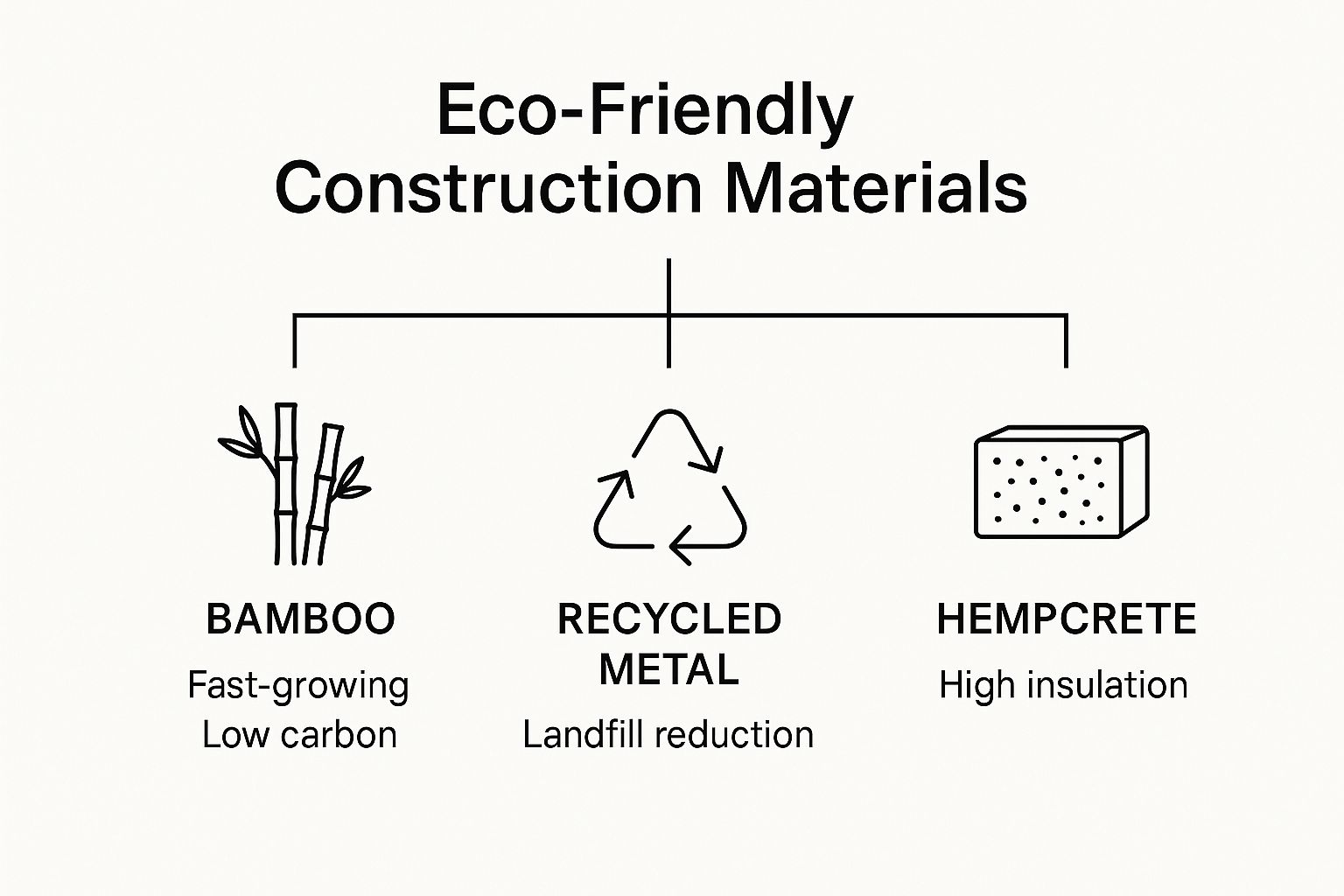
- Bamboo: It looks like wood, but it’s technically a grass that grows incredibly fast. It's strong, versatile, and brings a sleek, modern look to flooring and cabinetry.
- Cork: Harvested from the bark of cork oak trees without harming the tree, cork is an amazing renewable resource. It’s a natural insulator, resists water, and dampens sound.
- Straw Bale: This age-old technique uses compressed bales of agricultural waste for super-insulating walls. When properly sealed, it creates a highly energy-efficient building envelope perfect for California's varied climates.
High-Performance Composites
Composite materials are engineered products that combine different raw materials to create something with superior performance. Many are designed for sustainability, offering enhanced durability and a longer lifespan.
- Engineered Lumber: Products like laminated veneer lumber (LVL) and glulam beams use wood far more efficiently. They are often made from smaller, faster-growing trees to create structural components that are stronger and more stable than solid-sawn timber.
- Fiber Cement Siding: A tough mix of cement, sand, and cellulose fibers, fiber cement siding is built to last. It resists rot, fire, and pests, meaning less maintenance and fewer replacements—a perfect fit for demanding Bay Area weather.
Advanced Insulation Options
A building’s insulation is where the rubber meets the road for energy efficiency. Today's eco-friendly options not only slash heating and cooling bills but are also made from healthier, more sustainable sources.
- Sheep Wool: A natural, renewable fiber that's a game-changer for moisture management—a huge plus in damp, foggy parts of the Bay Area. It’s also a natural air purifier, capable of absorbing common indoor pollutants.
- Cellulose Insulation: Made from recycled paper, cellulose is a high-performance and cost-effective choice. It has very low embodied energy and provides excellent thermal and acoustic insulation.
The Real-World Benefits of Building Green
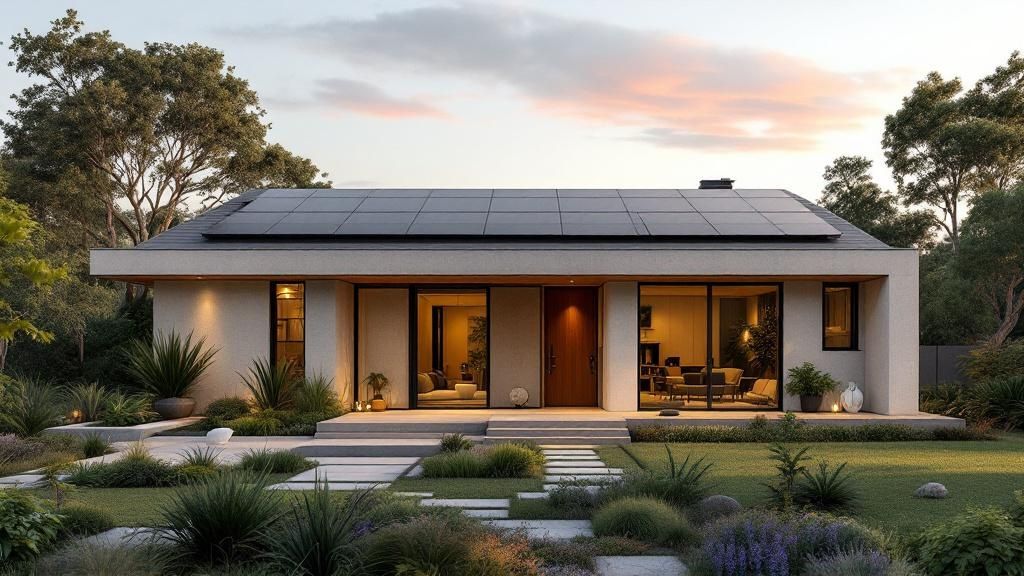
Choosing green materials delivers tangible returns that matter to everyone, from the builder on-site to the family moving in. For professionals in the Bay Area, understanding these returns isn't just about environmental responsibility; it's a solid business case. You're building properties that are more valuable, desirable, and comfortable.
Substantial Economic Advantages
One of the most compelling reasons to build green is the money it saves. While some sustainable materials might have a higher upfront cost, they deliver impressive dividends over the building's life.
- Reduced Utility Bills: High-performance insulation, energy-efficient windows, and a properly sealed building envelope drastically cut heating and cooling needs. According to ENERGY STAR, homeowners can save an average of 15% on heating and cooling just by air sealing their homes and adding insulation.
- Higher Property Value: Homes with green certifications are in high demand. Studies consistently show they can sell for more and spend less time on the market than conventional homes.
- Increased Durability and Lower Maintenance: Many eco-friendly materials are simply tougher. Their resistance to rot, pests, and harsh weather means fewer repairs and replacements, significantly lowering the total cost of ownership.
For instance, knowing the right way of insulating a metal roof for lasting comfort can make a world of difference in a building’s thermal performance.
Clear Environmental Gains
The positive ripple effect of using eco-friendly materials on the environment is undeniable. By making thoughtful choices, builders in Oakland, Berkeley, and across the region can dramatically shrink the environmental footprint of their projects.
The proof is in the numbers. According to the California Energy Commission, our state's building energy efficiency standards have saved Californians more than $100 billion in electricity bills since 1978. It's a powerful reminder of our collective impact.
Here’s what that looks like on the ground:
- Reduced Carbon Footprint: Sustainable materials often have lower embodied carbon and help buildings consume less energy.
- Less Construction Waste: Using reclaimed materials or precisely engineered components means less trash heading to our already-strained landfills.
- Conservation of Natural Resources: Opting for rapidly renewable materials like bamboo or products with recycled content helps preserve finite resources.
Improved Health and Wellness
Perhaps the most personal benefit is the creation of healthier indoor spaces. The quality of the air we breathe and the comfort of our homes directly impact our well-being.
Here’s how green materials contribute:
- Better Indoor Air Quality: Low-VOC or zero-VOC paints, adhesives, and finishes make the air inside cleaner and safer to breathe.
- Enhanced Thermal Comfort: A well-insulated building holds a stable temperature year-round, eliminating annoying drafts and hot spots.
- Superior Acoustic Performance: Materials like cork or cellulose insulation are fantastic at dampening sound, creating quieter and more peaceful interiors.
To dig deeper into boosting a home’s efficiency, check out our guide on home improvements for energy conservation.
How to Choose the Right Materials for Your Bay Area Project
Picking the right eco-friendly materials requires balancing project goals with measurable sustainability. This is a practical guide to making informed choices that fit your vision, budget, and the unique building demands of the Bay Area.
Start with Your Project’s Core Needs
First, what do you need these materials to do? A sustainable material is useless if it can’t handle the job, whether that’s holding up a second story or withstanding coastal fog.
Ask yourself these fundamental questions:
- What's its structural role? Is the material load-bearing, like engineered lumber, or purely aesthetic, like interior trim?
- What are the aesthetic goals? Are you matching the historic charm of a Berkeley bungalow or aiming for a modern Oakland loft?
- What's the budget? Be realistic. Balance the initial investment of a material against its long-term value and savings.
Analyze Performance in the Local Climate
Next, dig into how different materials will perform in the Bay Area’s diverse microclimates. Durability is a cornerstone of sustainability; a product that lasts longer means less waste and fewer resources spent on replacements.
Key Takeaway: For Bay Area contractors, performance means handling the persistent damp from San Francisco's fog, standing up to intense sun in inland valleys, or adding to a home's seismic resilience. A material's ability to endure our local conditions is what makes it a sustainable investment.
Zero in on these key performance metrics:
- Insulation Value (R-Value): How well does it resist heat flow? This is essential for meeting California’s Title 24 energy codes.
- Moisture Resistance: For any project near the coast, choosing materials that won’t warp, rot, or grow mold is critical.
- Maintenance Needs: Low-maintenance materials, like fiber cement siding, save time and money over the long haul.
For a deeper dive into selecting products built to last, check out our guide on choosing durable materials for contractors.
Verify Green Claims and Prioritize Local Sourcing
With "sustainability" as a major buzzword, you must verify a product's credentials. Look for trusted, third-party certifications like FSC for wood and review Environmental Product Declarations (EPDs) for transparent data on a material’s impact.
Finally, whenever possible, source your materials locally from a lumberyard near Oakland or Berkeley. This slashes transportation emissions and supports our local economy. A knowledgeable local partner can help you decipher technical data, ensure compliance, and align every choice with your project's sustainability goals.
Your Partner for Sustainable Building in the Bay Area
Choosing the right eco-friendly construction materials is critical, but a successful project truly hinges on the team you work with. At Truitt & White, we are your local partner, deeply rooted in the sustainable building community of the Bay Area. Our team understands the building codes and architectural styles that make Berkeley and Oakland unique.
We are committed to helping local builders, architects, and remodelers succeed. Our inventory includes FSC-certified lumber, high-performance engineered wood, and top-tier energy-efficient windows and doors from brands like Marvin and Andersen. We provide expert guidance to help you make choices that perfectly match your project's sustainability goals.
Let's Build Smarter, Together
Lean on our team's deep knowledge to find the perfect solutions for your next build or renovation. Getting in touch is the best first step you can take.
Our contact page connects you directly with our lumberyard and showroom teams for specialized advice. Let our experience work for you, ensuring every material choice is a smart, sustainable investment.
Ready to build green? Visit our Berkeley showroom for expert advice.
Frequently Asked Questions about Eco-Friendly Materials
Here are some of the most common questions we hear from builders, architects, and homeowners across the Bay Area. We provide straightforward, practical answers to help guide your next project.
1. Are eco-friendly materials always more expensive?
Not necessarily. While some materials may have a higher upfront cost, they often deliver a strong return on investment through lower utility bills, reduced maintenance, and increased property value. Many options, like cellulose insulation or reclaimed materials, can be cost-competitive from the start.
2. How can I be sure a material is actually sustainable?
Look for third-party certifications, which provide independent verification of a product's claims. Key labels to trust include FSC for wood, GREENGUARD for low chemical emissions, and Cradle to Cradle for products designed for a circular economy. These certifications cut through the "greenwashing" and ensure you are getting what you paid for.
3. Can I use green materials when renovating an older Bay Area home?
Absolutely. A renovation is a perfect opportunity to upgrade an older home with modern, sustainable performance. You can install high-efficiency windows that match historical aesthetics, add non-toxic sheep wool insulation to improve comfort and air quality, or use reclaimed lumber to preserve the home's unique character.
4. Do these materials meet California's strict building codes?
Yes, high-quality eco-friendly materials are often essential for meeting and exceeding California’s rigorous building standards, including Title 24. Products like high-performance insulation, cool roofing, and energy-efficient windows are designed for compliance. Working with a knowledgeable local supplier like Truitt & White ensures your materials are up to code.
5. What is the single most impactful "green" upgrade I can make?
If you can only make one change, focus on creating a high-performance building envelope. This system—which includes superior insulation, meticulous air sealing, and high-performance windows and doors—works together to drastically reduce energy consumption for heating and cooling. It provides the biggest bang for your buck in terms of energy savings and comfort.
At Truitt & White, we're committed to providing the Bay Area's building professionals with the highest quality eco-friendly materials and expert guidance. Visit our Berkeley showroom or connect with us online to discuss your project's needs.


